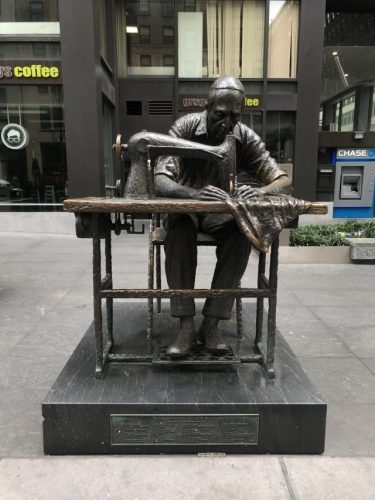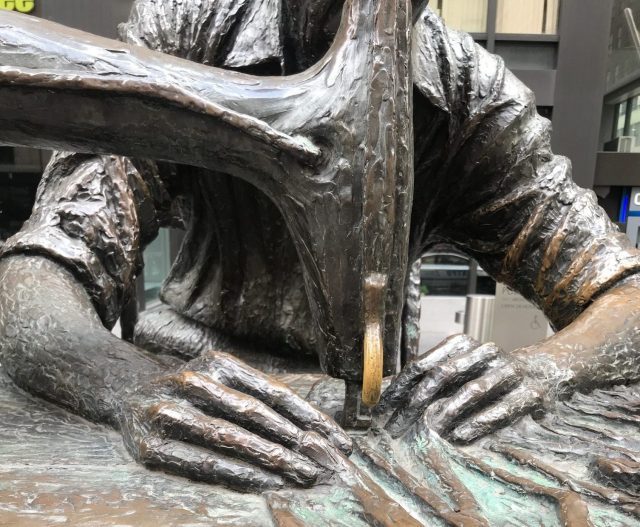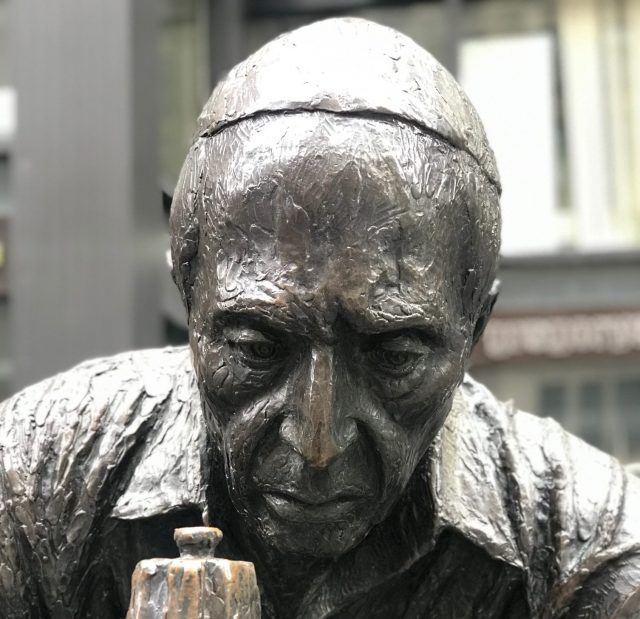
The Garment Worker keeps toiling away at 555 Seventh Avenue Plaza (photo by twi-ny/ees)
555 Seventh Avenue Plaza
Permanent installation
www.publicartfund.org
“Could it be that living through the time of coronavirus will reconfigure the organisation of fashion, fundamentally changing how brands practice their role? I hope it can be so,” Sarah Mower writes in a March 25 article for British Vogue. During the pandemic, many fashionistas, from major corporations to DIY home sewers, have stepped up to make masks, gloves, and other items for health-care workers on the front lines of the battle to stave off the infectious disease known as Covid-19.
The garment industry has been a centerpiece of American ingenuity since the 1800s. An enormous influx of immigrants around the turn of the twentieth century toiled in the industry, often in sweatshops churning out clothing and other items. Israeli-born, New York-based artist Judith Weller honored the immigrant employees with her eight-foot-high statue The Garment Worker, a tribute to her father, a garment industry machine operator. Weller expanded the piece from its original twenty-four-inch height; the large-scale sculpture was commissioned by the Public Art Fund and the International Ladies Garment Workers Union and donated to the city of New York by a wide range of garmentos, from Anne Klein, Bill Blass, Ellen Tracy, Liz Claiborne, and Ralph Lauren to the Amalgamated Clothing & Textile Workers Union, the Association of Rain Apparel Contractors, the Jewish Community Fund, the Ladies Apparel Contractors Association, and United Tool, among others. “When I was a little girl, I recall seeing him at work,” Weller said of her father at the time of the installation, which was initially scheduled to run from October 31, 1984, to the following Halloween but is now permanent. “I utilized what I know of him as well as my memory in creating the sculpture.”

Popular Garment District sculpture reveals skill and determination of fashion industry workers (photo by twi-ny/ees)
The bronze man, wearing a yarmulke, sits determinedly at his sewing machine, carefully stitching fabric. He’s focused on his hands, which delicately push down on the material; the table he works on is open to reveal his legs and feet. The drudgery is apparent on his stern face, as is his dedication to his task. Perhaps today the man would be making masks and gloves to save the lives of New Yorkers and other Americans. “The human figure expresses my struggle, anxiety, frustration, yearning, and hope. It offers unlimited and inexhaustible possibilities,” Weller explains in her artist statement.
The Garment Worker continues to work every day in the shadow of the giant button and needle that lean on the Garment District Information Kiosk at the corner of Thirty-Ninth St. and Seventh Ave. (Fashion Ave.). He is no mere relic of the past but a reminder of who we all are and where we came from, and what we can do to maintain the country’s ever-more-fragile infrastructure.

Judith Weller honors her Jewish immigrant father with statue (photo by twi-ny/ees)
“The big question is whether this spontaneous surge of human spirit, practicality, and creativity will grow strongly enough, for long enough, to turn fashion’s priorities around,” Mower writes in British Vogue. “Will this nightmare time actually become a historic and positive turning point, converting both industry producers and wearers to, literally, a new way of seeing and valuing clothes? There’s a possibility that all these weeks of staying at home will result in discovering a streak of waste-not creativity we never knew we had.” That evaluation is right on the button, hitting the . nail on the head.